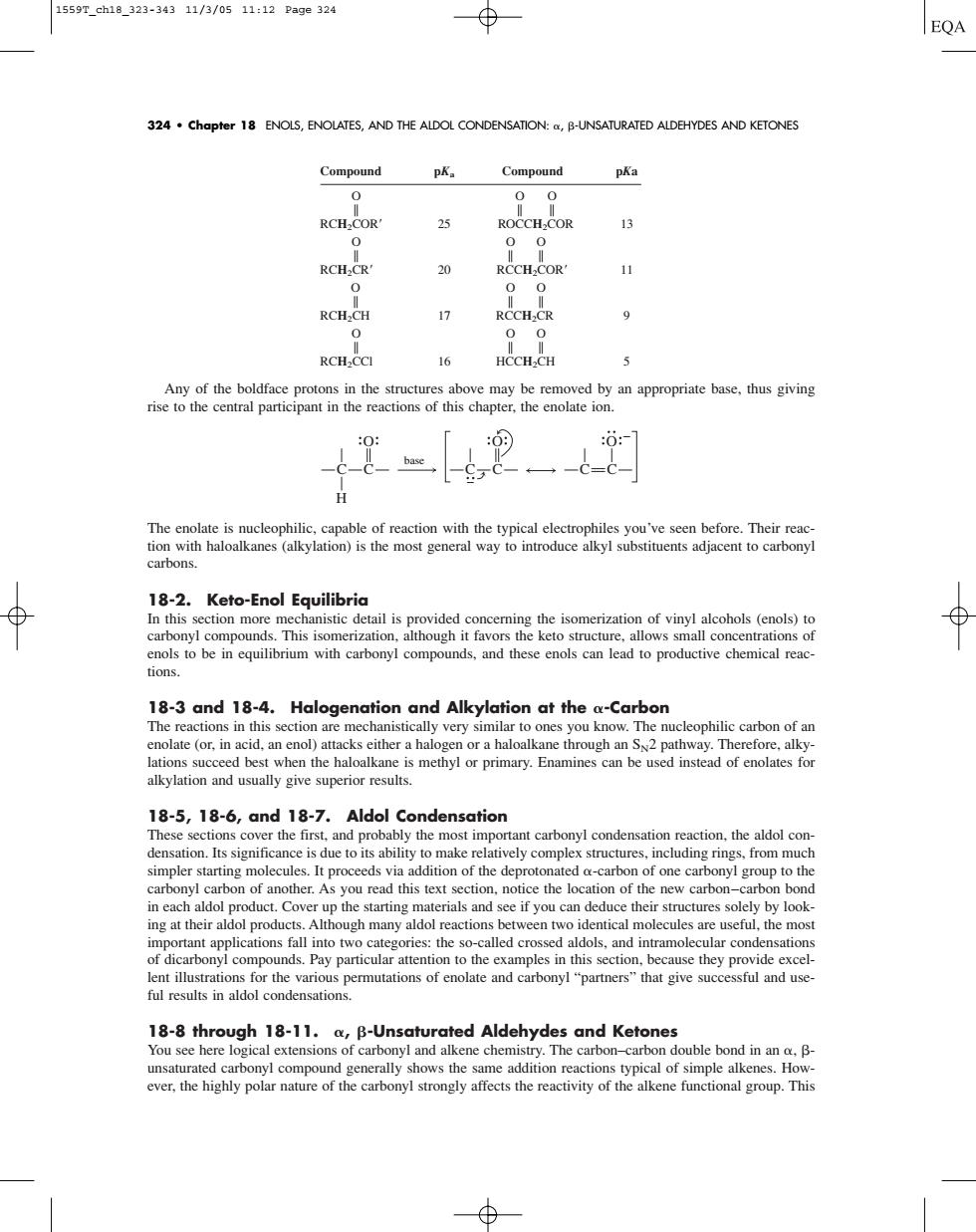正在加载图片...

1559T_ch18_323-34311/3/0511:12Page324 EQA 324.Chapter 18 ENOLS,ENOLATES,AND THE ALDOL CONDENSATION:B-UNSATURATED ALDEHYDES AND KETONES Compound pK. Compound 0 00 RCH.COR 35 ROCCH.COR 13 00 RCH.CR 20 11 RCH-CH 17 RCCH.CR 9 00 RCH.CCI 16 HCCH.CH a盒ethn 09 一-c=c The enolate is nucleophilic able of reaction with the 18-2.Keto-Enol Equilibria In this section more mechanistic detail is provided conceming the isomerization of vinyl alcohols(enols)to compoun tions. similar to d.an cnd)atacks citer halogen or aere ay n th oalkane is methyl or primary.Enamines can be used instead of enolates for 18-5,18-6,and 18-7.Aldol Condensation and pro Smplrtatingmolelesitpoeedsvaddionofhedepoomedacatoaofoaecatonigopothie ce the location of the new carbon- on bone mportant applica t illustration or the ns of nola and caro ful results in aldol condensations. carbonyl strongly affects the reactivity of the alkene fun ctonal group.This Compound pKa Compound pKa O OO B BB RCH2COR 25 ROCCH2COR 13 O OO B BB RCH2CR 20 RCCH2COR 11 O OO B BB RCH2CH 17 RCCH2CR 9 O OO B BB RCH2CCl 16 HCCH2CH 5 Any of the boldface protons in the structures above may be removed by an appropriate base, thus giving rise to the central participant in the reactions of this chapter, the enolate ion. The enolate is nucleophilic, capable of reaction with the typical electrophiles you’ve seen before. Their reaction with haloalkanes (alkylation) is the most general way to introduce alkyl substituents adjacent to carbonyl carbons. 18-2. Keto-Enol Equilibria In this section more mechanistic detail is provided concerning the isomerization of vinyl alcohols (enols) to carbonyl compounds. This isomerization, although it favors the keto structure, allows small concentrations of enols to be in equilibrium with carbonyl compounds, and these enols can lead to productive chemical reactions. 18-3 and 18-4. Halogenation and Alkylation at the -Carbon The reactions in this section are mechanistically very similar to ones you know. The nucleophilic carbon of an enolate (or, in acid, an enol) attacks either a halogen or a haloalkane through an SN2 pathway. Therefore, alkylations succeed best when the haloalkane is methyl or primary. Enamines can be used instead of enolates for alkylation and usually give superior results. 18-5, 18-6, and 18-7. Aldol Condensation These sections cover the first, and probably the most important carbonyl condensation reaction, the aldol condensation. Its significance is due to its ability to make relatively complex structures, including rings, from much simpler starting molecules. It proceeds via addition of the deprotonated -carbon of one carbonyl group to the carbonyl carbon of another. As you read this text section, notice the location of the new carbon–carbon bond in each aldol product. Cover up the starting materials and see if you can deduce their structures solely by looking at their aldol products. Although many aldol reactions between two identical molecules are useful, the most important applications fall into two categories: the so-called crossed aldols, and intramolecular condensations of dicarbonyl compounds. Pay particular attention to the examples in this section, because they provide excellent illustrations for the various permutations of enolate and carbonyl “partners” that give successful and useful results in aldol condensations. 18-8 through 18-11. , -Unsaturated Aldehydes and Ketones You see here logical extensions of carbonyl and alkene chemistry. The carbon–carbon double bond in an , - unsaturated carbonyl compound generally shows the same addition reactions typical of simple alkenes. However, the highly polar nature of the carbonyl strongly affects the reactivity of the alkene functional group. This O base C C H O C C O C C 324 • Chapter 18 ENOLS, ENOLATES, AND THE ALDOL CONDENSATION: , -UNSATURATED ALDEHYDES AND KETONES 1559T_ch18_323-343 11/3/05 11:12 Page 324������